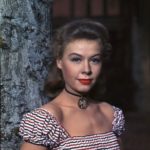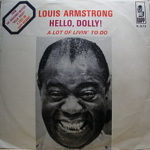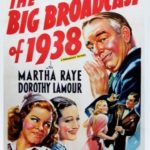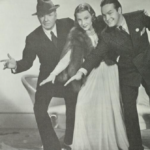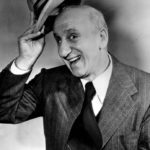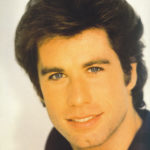 Happy Birthday to two-time Oscar nominee John Travolta, born Feb. 18, 1954, in Englewood, N.J. His mother taught high school drama, and most of his five siblings pursued performing careers. By age 12, Travolta was already acting in local troupes. At 16, he dropped out of Dwight Morrow H.S. to make his professional debut in the Off-Broadway play Rain. Soon after, he landed a role in a national touring company of Grease and, within a year, was making his Broadway debut in the musical as Doody, onstage with his sister Ann. His next Broadway role was Misfit in the 1974 Andrews Sisters musical Over Here!, in which he sang the specialty solo “Dream Drummin’.” Below is the original cast at the Tony Awards, with Travolta among the chorus in “Charlie’s Place” (about 4:17).
Happy Birthday to two-time Oscar nominee John Travolta, born Feb. 18, 1954, in Englewood, N.J. His mother taught high school drama, and most of his five siblings pursued performing careers. By age 12, Travolta was already acting in local troupes. At 16, he dropped out of Dwight Morrow H.S. to make his professional debut in the Off-Broadway play Rain. Soon after, he landed a role in a national touring company of Grease and, within a year, was making his Broadway debut in the musical as Doody, onstage with his sister Ann. His next Broadway role was Misfit in the 1974 Andrews Sisters musical Over Here!, in which he sang the specialty solo “Dream Drummin’.” Below is the original cast at the Tony Awards, with Travolta among the chorus in “Charlie’s Place” (about 4:17).
Travolta left New York to pursue film and TV work in Los Angeles, landing his breakthrough role as Vinnie Barbarino in the sitcom Welcome Back, Kotter (1975-79), in which his sister Ellen had a recurring role. With his newfound success, he released a series of pop albums, including John Travolta, Can’t Let Go, and Travolta Fever. He had a Top Ten hit with “Let Her In” from his debut and landed in the Top 40 with “Whenever I’m Away from You” from his third album. Below is Travolta performing “Let Her In” on the April 10, 1976, episode of Dick Clark’s American Bandstand.
https://youtu.be/fZFM4Zx2JNU
Travolta won critical acclaim for the 1976 TV film The Boy in the Plastic Bubble and the 1977 feature film Saturday Night Fever (1977), which earned him his first Oscar and Golden Globe nominations and made him an icon of the disco era. Below is the classic “You Should Be Dancing” scene from the film.
The following year, Travolta starred in film adaptation of Grease, this time in the lead role of Danny Zuko. It was an even larger success than Saturday Night Fever, earning Travolta his second Golden Globe nomination and his first Grammy nomination for the soundtrack. The album topped the Billboard 200 chart, while the single “You’re the One That I Want” topped both the U.S. and U.K. charts. The single “Summer Nights” also landed at #5 in the U.S. and #1 in the U.K. Below is the film clip of “You’re the One That I Want” with Travolta and Olivia Newton-John.
Travolta’s career took a downturn in the 1980s with films like the sequel Staying Alive, which earned him a Razzie nomination, but his work with Newton-John on the soundtrack for the 1983 film Two of a Kind produced the Top 10 adult contemporary hit “Take a Chance,” which you can watch below.
He saw a resurgence in the 1990s, after the 1994 crime drama Pulp Fiction, which earned Travolta his second Oscar and Golden Globe nominations, and he focused primarily on nonmusical projects for the next decade, including Get Shorty (Globe win) and Primary Colors (Globe nom). His next musical film was the 2007 adaptation of the Tony-winning Hairspray, which earned Travolta another Globe nod. The soundtrack peaked at #2 on the Billboard 200 and was nominated for a Grammy. Below is a film clip of his turn in the song “You Can’t Stop the Beat.”
In the past decade, Travolta has continued to earn critical acclaim for his dramatic work, including Emmy and Golden Globe nominations for The People v. O. J. Simpson: American Crime Story, and reunited with Newton-John on her 2012 holiday album This Christmas. Below is the video for “I Think You Might Like It.”


